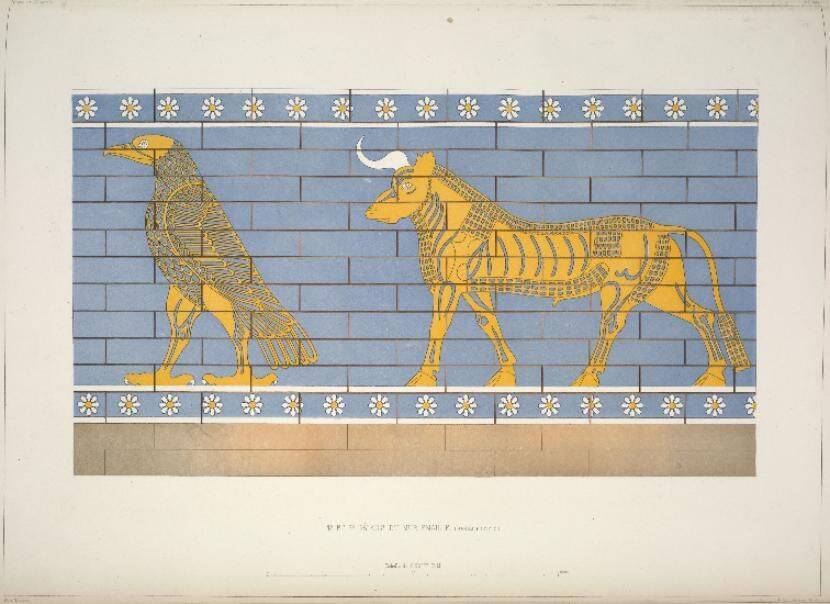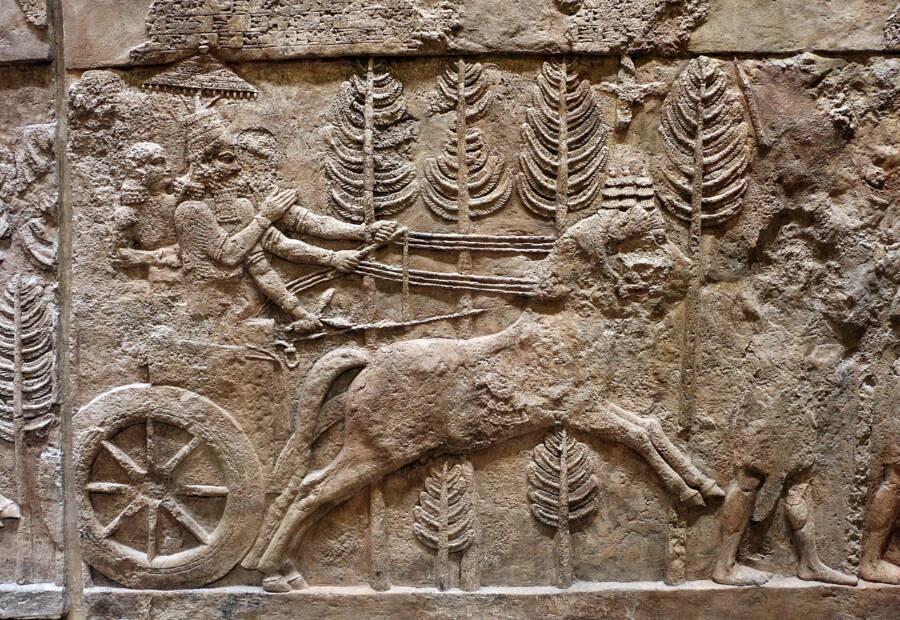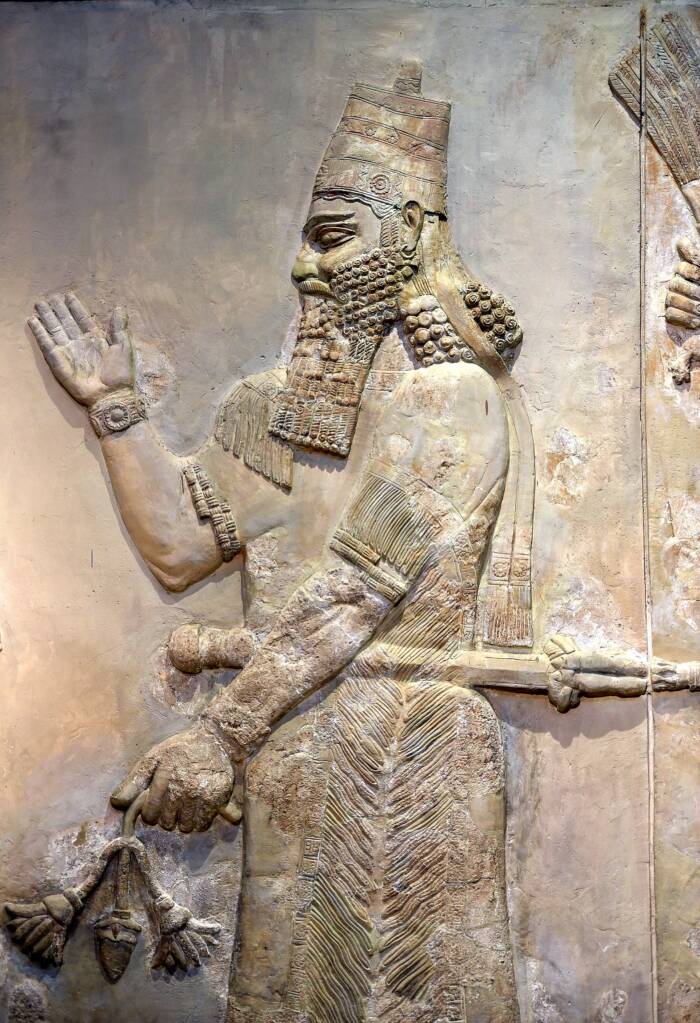The five symbols have been found across the ancient city of Dūr-Šarrukīn, but they've long stumped researchers — until now.

New York Public LibraryThe symbols include a lion, an eagle, a bull, a fig tree, and a plow.
In the 19th century, French excavators noticed a number of symbols around the ancient city of Dūr-Šarrukīn (present-day Khorsabad, Iraq). But neither they nor the researchers that followed were able to determine what the symbols meant. Now, a new theory has been put forth.
Assyriologist Dr. Martin Worthington of Trinity College Dublin believes that he’s finally cracked this ancient mystery. And it all has to do with kings and stars.
Interpreting The Assyrian Symbols
The “mystery symbols” — a lion, an eagle, a bull, a fig tree, and a plow — have been documented throughout the ancient city of Dūr-Šarrukīn. Between 721 and 704 B.C.E., the city was ruled by Sargon II, the king of Assyria.
According to a new article in the Bulletin of the American Society of Overseas Research, Trinity College Dublin Assyriologist Martin Worthington believes that the five symbols have to do with Sargon himself. Specifically, Worthington argues that the icons spell out the king’s name.
“[N]ot-so-long ago I wrote a long book all about word play in the Gilgamesh Flood story, and I think I developed a habit of being on the lookout for this sort of thing,” Worthington told All That’s Interesting in an email.

Sailko/Wikimedia CommonsSargon II as depicted in a relief found in one of his palaces.
Worthington continued: “My idea about this… is that the lion represents the idea of royalty (a connection which we can document in Mesopotamian sources), thereby giving the idea of ‘king’ – the šar or sar element of Sargon’s name… I approached the five symbols in light of all this, and like previous researchers I felt there was a very good chance that they might be writing his name. First I wondered whether he (or rather those who came up with it for him) might have been using Aramaic words, which didn’t work, and then… the Assyrian/Babylonian words magically fell into place.”
Worthington also suspects that the same can be said of just three symbols (the lion, the tree, and the plow). This shortened version of the sequence was also found around Dūr-Šarrukīn, and Worthington believes it spells out the king’s name as well.
What’s more, Worthington theorizes that the symbols also represent constellations (many of which are the same we use today, since modern-day constellations were based on ancient ones). The lion represents Leo, the eagle Aquila, and the fig tree “the Jaw,” which no longer exists.
“Other people had already pointed out that the yellow-and-blue colors looked really suggestive of the night sky,” Worthington explained to All That’s Interesting. “So then I started rummaging among Mesopotamian star lists, and suddenly realised that iṣu ‘tree’ sounds uncannily similar to isu ‘jaw.’ That was another ‘aha!’ moment!”

New York Public LibraryThe lion symbol may represent both the constellation Leo and part of Sargon’s name.
In a Trinity College Dublin statement Worthington further explained: “The effect of the five symbols was to place Sargon’s name in the heavens, for all eternity — a clever way to make the king’s name immortal.”
Indeed, Sargon II had grand visions for his kingdom.
The Short-Lived Glory Of Sargon II And Dūr-Šarrukīn
By the time Sargon rose to power in the 8th century B.C.E., Mesopotamia was already the “cradle of civilization.” Writing was likely invented in the region around 3400 B.C.E., and the Mesopotamian habit of counting in sets of 60 led to the practice of putting 60 minutes in an hour.
Sargon, too, hoped to leave his mark on history.

Osama Shukir Muhammed Amin FRCP(Glasg)/Wikimedia CommonsA relief of King Sargon II, the 8th-century B.C.E. king of Assyria.
The circumstances around his ascension to the throne in 721 B.C.E. are murky — Sargon may have staged a coup d’état to overthrow his brother — but once he took power he sought to expand his empire. Inspired by the national god of the Assyrian empire, Ashur, he instituted a policy of conquest.
The Assyrian empire flourished under his command, and Sargon constructed the city of Dūr-Šarrukīn as the new capital. Said to be his obsession, the city came to encompass 11 square miles surrounding a palace that Sargon boasted would be “without rival.”
But when Sargon was killed in battle around 704 B.C.E., the city of Dūr-Šarrukīn was largely abandoned. The capital was moved to Nineveh instead.
Worthington’s interpretation of the Assyrian symbols offers a fresh look at this fascinating civilization. It certainly makes sense that Sargon’s city would be decorated with symbols representing his name and linking the king to the heavens. But even Worthington admits that his theory isn’t foolproof.
“I can’t prove my theory, but the fact it works for both the five-symbol sequence and the three-symbol sequence, and that the symbols can also be understood as culturally appropriate constellations, strikes me as highly suggestive,” he noted in the university statement. “The odds against it all being happenstance are — forgive the pun — astronomical.”
After reading about the new interpretation of “mystery” Assyrian symbols, discover the story of the Anunnaki, the mysterious ancient “alien” gods of Mesopotamia. Or, learn about Pazuzu, the terrifying Mesopotamian demon that later inspired The Exorcist.





